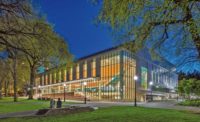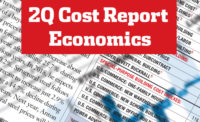As Silicon Valley has focused on growth through innovation, so has BKF Engineers. The 100-plus-year-old company has been offering civil engineering specialties since railroad surveyor Willis “Jack” Frost set up shop in Redwood City in 1915.
Discovering new ways to work with public and private partners in order to find creative solutions to infrastructure puzzles has helped the company grow to 12 offices and 400 employees and has helped produce some of the most iconic structures in California. As a result of that growth, a focus on sustainability and a strong connection to the community, BKF has been named ENR California’s Design Firm of the Year.
Article Index:
Master Planners
Almost from the beginning, the company used a full service, consultative approach to large infrastructure projects, taking on master planning support and entitlement processing along with traditional civil engineering at a time when that sort of planning was still relatively new. The company jumped in to write technical reports for environmental clearances, grant funding applications and right-of-way acquisitions. “We help our clients clear lots of the hurdles to getting a project off the drawing boards and out to construction,” says David LaVelle, BKF president and CEO.
It’s an approach appreciated by Bill Phillips, senior associate and vice president for Stanford University, who credits BKF’s collaborative approach to land use for building some of the landmarks on the campus.
Examples of other big, comprehensive projects in the Bay Area include Treasure Island, home to 8,000 new housing units, and Hunters Point, which will include 12,000 housing units along with office, R&D and mixed-use space.
“We come in with a SWAT team approach” on major projects that need to be coordinated with multiple jurisdictions, contractors and agencies, says LaVelle.
Stephen Biggs, president of San Jose-based Biggs Cardosa Associates, says his firm has been working closely with BKF for 30 years. BKF’s “hands-on” management approach, technical excellence and creative and unique design solutions have provided the basis for a great partnership that has successfully completed hundreds of projects together, he says.
Sustainable Growth
BKF Engineers’ revenue grew by nearly 60% in the last two years. The company’s location in Silicon Valley—one of the fastest-growing areas of the country—certainly doesn’t hurt. However, LaVelle stresses that working with a company like Google or Oracle to build a new headquarters demands creative ways of looking at land use. “High-tech firms have a strong vision of the campus environment they want to provide for their employees, and they are committed to sustainable design,” he says.
BKF’s civil design on the Oracle project in Redwood City included helping to secure entitlements and permits, developing a rapid schedule and design-build delivery method and complying with strict stormwater quality requirements in a limited space. The solution was the construction of three bioretention areas to capture 80% of runoff.
BKF is currently helping to coordinate design for the under-construction 1.3-million-sq-ft Salesforce Tower, which already looms over the San Francisco skyline. BKF’s role includes design of utility capacity and a stormwater control plan for the sensitive, crowded site.
The company is also playing key roles in the 430,000-sq-ft Facebook addition known as MPK 20 and the 185,000-sq-ft Intuit campus expansion in Mountain View.
Todd Adair, BKF vice president, says that sustainability is huge in California and companies put a big emphasis on reducing project impacts, which is why BKF engineers have made it a priority to be experts in everything from permeable pavements and bioretention to material recycling and recycled water.
For most clients, sustainability requires balancing impacts with costs. “You have to consider long term the amount of maintenance that will be required over time by owner-operators in addition to the cost of installing a solution. That is part of considering the user experience,” he says.
Power of Technology
One way that BKF has been able to deliver for these demanding clients has been by using technology in new ways. For the Salesforce Tower, for instance, crews used laser scanners to control the concrete surface vertically. The central core of the tower includes a high speed elevator with very low tolerance for variance. Using laser scanners as each set of floors is completed allowed for precise quality control and immediate corrections.
BKF was an early adopter of project management software and BIM used for clash detection and to better understand component interaction. Now, design change time lines are measured and delivered in minutes rather than days.
“We started pre-CAD with pen and ink. A lot has changed, but the entrepreneurial spirit remains the same,” Adair says.
Public-Private Scope
Because BKF has worked on public infrastructure projects such as the Bay Area Rapid Transit extension and Gerald Desmond Bridge in Long Beach, it understands how government agencies work and has developed expertise working with complex projects that straddle multiple jurisdictions. “Traffic and transportation has become a critical element in California’s future as the state matures and communities increase in density,” LaVelle says.
The North Connector Project to expand vehicle capacity along Interstate 80 in Solano County northeast of San Francisco is an example of how BKF helps local agencies “deliver major transportation projects which require working with a lot of other agencies,” says Janet Adams, deputy executive director for the Solano Transportation Authority.
Private companies often have a sense of urgency and come with their own unique goals. For instance, Adair says, the user experience is very important to technology companies competing to provide the best and most productive environment for valuable employees. But they also appreciate the knowledge BKF brings to the planning and approval portion of the project and the relationships they have built with developers, architects and jurisdictions over time. “This has become a much bigger part of the job in order to meet our client’s goals,” LaVelle says.
Combined with the work BKF has done for foundations on projects like the Golden State Warriors Arena now being developed in San Francisco, this diversification of client types has helped the company grow even during times when one sector is on the decline.
Focus on People
David Richwood, BKF vice president, says that the company has a secret weapon when it comes to delivering thoughtful projects: its employees. While the wall of awards for “top workplace” and “best firms to work for” in the North Bay is nice, he sees a focus on employee satisfaction as one of the reasons the company has been so successful. He points to the long tenure for employees: The core group has an average of 20-plus years at the company.
“It’s all about the people who pull the wagon,” Richwood says.








Post a comment to this article
Report Abusive Comment